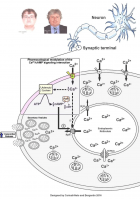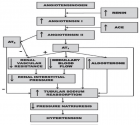Abstract
Mini Review
Novel Challenges for the Therapeutics of Depression: Pharmacological Modulation of Interaction between the Intracellular Signaling Pathways Mediated by Ca2+ and cAMP
Afonso Caricati-Neto and Leandro Bueno Bergantin*
Published: 30 January, 2017 | Volume 1 - Issue 1 | Pages: 001-006
Depression is a psychiatric disease resulting mainly by dysfunction of serotoninergic and monoaminergic neurotransmission in central nervous system (CNS). Due to the multifaceted nature of depression and our limited understanding on its etiology, depression is difficult to be treated with currently available pharmaceuticals. Then, new therapeutic strategies for depression have been proposed. Since 1975, several clinical studies have reported that L-type Ca2+ channel blockers (CCBs), used in anti-hypertensive therapy, produce increase of plasma catecholamine levels and tachycardia, typical symptoms of sympathetic hyperactivity. Despite these adverse effects of CCBs have been initially attributed to adjust reflex of arterial pressure, during almost four decades these enigmatic phenomena remained unclear. In 2013, we discovered that this paradoxical sympathetic hyperactivity produced by CCBs results from the increase of catecholamines release from sympathetic nerves, and adrenal chromaffin cells, due to its modulatory action on the interaction between intracellular signaling pathways mediated by Ca2+ and cAMP (Ca2+/cAMP signalling interaction). Then, the pharmacological modulation of this interaction by combined use of L-type CCBs, and cAMP-enhancer compounds, could be a more efficient (and safer) therapeutic strategy to produce increase of serotoninergic and monoaminergic neurotransmission in the CNS due to enhance of serotonin and monoamines release, thus attenuating clinical symptoms of depression in humans.
Read Full Article HTML DOI: 10.29328/journal.jatr.1001001 Cite this Article Read Full Article PDF
Keywords:
Ca2+/cAMP signaling interaction; serotoninergic neurotransmission; Monoaminergic neurotransmission; Depression
References
- Caricati-Neto A, García AG, Bergantin LB. Pharmacological implications of the Ca2+/cAMP signalling interaction: from risk for antihypertensive therapy to potential beneficial for neurological and psychiatric disorders. Pharmacol Res Perspect. 2015; 3: e00181. Ref.: https://goo.gl/BBr2kt
- Pytka K, Podkowa K, Rapacz A, Podkowa A, Żmudzka E, et al. The role of serotonergic, adrenergic and dopaminergic receptors in antidepressant-like effect. Pharmacol Rep. 2016; 68: 263-274. Ref.: https://goo.gl/MP8VUK
- Bergantin LB, Souza CF, Ferreira RM, Smaili SS, Jurkiewicz NH, et al. Novel model for “calcium paradox” in sympathetic transmission of smooth muscles: role of cyclic AMP pathway. Cell Calcium. 2013; 54: 202-212. Ref.: https://goo.gl/NeN9ha
- Bergantin LB, Jurkiewicz A, García AG, Caricati-Neto A. A Calcium Paradox in the Context of Neurotransmission. J Pharm Pharmacol. 2015; 3: 253-261. Ref.: https://goo.gl/hl07Cc
- Bergantin LB, Caricati-Neto A. Challenges for the pharmacological treatment of neurological and psychiatric disorders: Implications of the Ca2+/cAMP intracellular signalling interaction. Eur J Pharmacol. 2016; 788, 255-260. Ref.: https://goo.gl/ItZfbz
- Bergantin LB, Caricati-Neto A. Insight from “Calcium Paradox” due to Ca2+/cAMP Interaction: Novel Pharmacological Strategies for the Treatment of Depression. Int Arch Clin Pharmacol. 2016; 2: 2-7. Ref.: https://goo.gl/QPbmtY
- Bergantin LB, Caricati-Neto A. Novel Insights for Therapy of Parkinson’s disease: Pharmacological Modulati on of the Ca2+/cAMP Signalling Interaction. Austin Neurol & Neurosci. 2016; 1: 1-4. Ref.: https://goo.gl/XkpzIH
- Bergantin LB, Caricati-Neto A. Recent advances in pharmacotherapy of neurological and psychiatric disorders promoted by discovery of the role of Ca2+/cAMP signaling interaction in the neurotransmission and neuroprotection. Adv Pharmac J. 2016; 1: 66-70. Ref.: https://goo.gl/9ypgJo
- Kaster MP, Moretti M, Cunha MP, Rodrigues AL (2016). Novel approaches for the management of depressive disorders. Eur J Pharmacol. 2016; 771: 236-40. Ref.: https://goo.gl/Z5fvbG
- Köhler S, Cierpinsky K, Kronenberg G, Adli M . The serotonergic system in the neurobiology of depression: Relevance for novel antidepressants. J Psychopharmacol. 2016; 30: 13-22. Ref.: https://goo.gl/nmmzva
- Douglas WW, Rubin RP. The role of calcium in the secretory response of the adrenal medulla to acetylcholine. J Physiol. 1961; 159: 40-57. Ref.: https://goo.gl/9uWF59
- Baker PF, Knight DE. Calcium-dependent exocytosis in bovine adrenal medullary cells with leaky plasma membranes. Nature; 1978; 276: 620-622. Ref.: https://goo.gl/ifjTU3
- Chern YJ, Kim KT, Slakey LL, Westhead EW. Adenosine receptors activate adenylate cyclase and enhance secretion from bovine adrenal chromaffin cells in the presence of forskolin. J Neurochem. 1988; 50: 1484-1493. Ref.: https://goo.gl/Z25XIH
- Cooper DM, Mons N, Karpen JW. Adenylyl cyclases and the interaction between calcium and cAMP signalling. Nature. 1995; 374: 421-424. Ref.: https://goo.gl/w9JkIm
- Yule DI, Betzenhauser MJ, Joseph SK. Linking structure to function: recent lessons from inositol 1,4,5-trisphosphate receptor mutagenesis. Cell Calcium. 2010; 47: 469-479. Ref.: https://goo.gl/qZbaac
- Ahuja M, Jha A, Maléth J, Park S, Muallem S. cAMP and Ca²⁺ signaling in secretory epithelia: crosstalk and synergism. Cell Calcium. 2014; 55: 385-93. Ref.: https://goo.gl/v5sEi7
- Grossman E, Messerli FH. Effect of calcium antagonists on sympathetic activity. Eur Heart J. 1998; 19: 27-31. Ref.: https://goo.gl/3VaR2B
- Kreye VA, Luth JB. Proceedings: verapamil-induced phasic contractions of the isolated rat vas deferens. Naunyn Schmiedebergs Arch Pharmacol. 1975; 287: R43. Ref.: https://goo.gl/34bQaA
- French AM, Scott NC. A comparison of the effects of nifedipine and verapamil on rat vas deferens. Br J Pharmacol. 1981; 73: 321-323. Ref.: https://goo.gl/gfli14
- Moritoki H, Iwamoto T, Kanaya J, Maeshiba Y, Ishida Y, et al. Verapamil enhances the non-adrenergic twitch response of rat vas deferens. Eur J Pharmacol. 1987; 140: 75-83. Ref.: https://goo.gl/0yeqf1
- Prakhie IV, Oxenkrug GF. The effect of nifedipine, Ca(2+) antagonist, on activity of MAO inhibitors, N-acetylserotonin and melatonin in the mouse tail suspension test. Int J Neuropsychopharmacol. 1998; 1: 35-40. Ref.: https://goo.gl/qDZmkH
- Ogihara T, Nakagawa M, Ishikawa H, Mikami H, Takeda K, et al. Effect of manidipine, a novel calcium channel blocker, on quality of life in hypertensive patients. Blood Press Suppl. 1992; 3: 135-139. Ref.: https://goo.gl/OCWfvh
- Veng LM, Mesches MH, Browning MD. Age-related working memory impairment is correlated with increases in the L-type calcium channel protein α1D (Cav1.3) in area CA1 of the hippocampus and both are ameliorated by chronic nimodipine treatment. Brain Res Mol Brain Res. 2003; 110: 193-202. Ref.: https://goo.gl/J1Igy5
- Chan CS, Guzman JN, Ilijic E, Mercer JN, Rick C, et al. ‘Rejuvenation’ protects neurons in mouse models of Parkinson’s disease. Nature. 2007; 447: 1081-1086. Ref.: https://goo.gl/d2EjVz
- Tsukuda K, Mogi M, Li JM, Iwanami J, Min LJ, et al. Diabetes-associated cognitive impairment is improved by a calcium channel blocker, nifedipine. Hypertension. 2008; 51: 528-533. Ref.: https://goo.gl/zgud8g
- Sommer N, Loschmann PA, Northoff GH, Weller M, Steinbrecher A, et al. The antidepressant rolipram suppresses cytokine production and prevents autoimmune encephalomyelitis. Nat Med. 1995; 1: 244-248. Ref.: https://goo.gl/eXv7C8
- Li YF, Cheng YF, Huang Y, Conti M, et al. Phosphodiesterase-4D knock-out and RNA interference-mediated knock-down enhance memory and increase hippocampal neurogenesis via increased cAMP signaling. J Neurosci. 2011; 31: 172-183. Ref.: https://goo.gl/fCsYtf
- Xiao L, O'Callaghan JP, O'Donnell JM. Effects of repeated treatment with phosphodiesterase-4 inhibitors on cAMP signaling, hippocampal cell proliferation, and behavior in the forced-swim test. J Pharmacol Exp Ther. 2011; 338: 641-647. Ref.: https://goo.gl/myAhrx
- De Vry J, Fritze J, Post R. The management of coexisting depression in patients with dementia: potential of calcium channel antagonists. Clinical Neuropharmacology. 1997; 20: 22-35. Ref.: https://goo.gl/OIvzJr
- Vetulani J. The action of antidepressant drugs administered during calcium channel blockade. Pol J Pharmacol. 1993; 45: 179-84. Ref.: https://goo.gl/IfGE3E
- Taragano FE, Bagnatti P, Allegri RF. A double-blind, randomized clinical trial to assess the augmentation with nimodipine of antidepressant therapy in the treatment of "vascular depression". Int Psychogeriatr. 2005; 17: 487-498. Ref.: https://goo.gl/19kry3
Figures:

Figure 1
Similar Articles
-
Novel Challenges for the Therapeutics of Depression: Pharmacological Modulation of Interaction between the Intracellular Signaling Pathways Mediated by Ca2+ and cAMPAfonso Caricati-Neto,Leandro Bueno Bergantin*. Novel Challenges for the Therapeutics of Depression: Pharmacological Modulation of Interaction between the Intracellular Signaling Pathways Mediated by Ca2+ and cAMP . . 2017 doi: 10.29328/journal.jatr.1001001; 1: 001-006
-
Psychosocial factors among end-stage kidney disease patients receiving hemodialysis treatment in Kumasi, GhanaThomas Nti Amoako*,Frances Emily Owusu-Ansah. Psychosocial factors among end-stage kidney disease patients receiving hemodialysis treatment in Kumasi, Ghana. . 2021 doi: 10.29328/journal.jatr.1001017; 5: 014-019
-
Drug Rehabilitation Centre-based Survey on Drug Dependence in District Shimla Himachal PradeshKanishka Saini,Palak Sharma,Bhawna Sharma*,Atul Kumar Dubey,Muskan Bhatnoo,Prajkta Thakur,Vanshika Chandel,Ritika Sinha. Drug Rehabilitation Centre-based Survey on Drug Dependence in District Shimla Himachal Pradesh. . 2025 doi: 10.29328/journal.jatr.1001032; 9: 001-006
Recently Viewed
-
Satellite-Based Analysis of Air Pollution Trends in Khartoum before and After the ConflictHossam Aldeen Anwer*,Abubakr Hassan,Ghofran Anwer. Satellite-Based Analysis of Air Pollution Trends in Khartoum before and After the Conflict. Ann Civil Environ Eng. 2025: doi: 10.29328/journal.acee.1001074; 9: 001-011
-
Bioinformatics as a modern tool in forensic science for data understanding & investigation in researchPranav Kumar Ray*. Bioinformatics as a modern tool in forensic science for data understanding & investigation in research. J Forensic Sci Res. 2022: doi: 10.29328/journal.jfsr.1001040; 6: 083-087
-
Biotechnology in Forensic Science: Advancements and ApplicationsSunny Antil,Vandana Joon*. Biotechnology in Forensic Science: Advancements and Applications. J Forensic Sci Res. 2025: doi: 10.29328/journal.jfsr.1001073; 9: 007-014
-
A comparative study of post-operative astigmatism in superior versus superotemporal scleral incisions in manual small incision cataract surgery in a tertiary care hospitalSoumyadeep Hazra*,Tapes Kanti Saha. A comparative study of post-operative astigmatism in superior versus superotemporal scleral incisions in manual small incision cataract surgery in a tertiary care hospital. Int J Clin Exp Ophthalmol. 2021: doi: 10.29328/journal.ijceo.1001036; 5: 009-015
-
Heart Rate Variability Biofeedback and Psychotherapy in Polycystic Ovary Syndrome: Description of a Case Report to Shed Light on this Understudied ConditionCarlo Pruneti, Sara Guidotti*, Chiara Cosentino. Heart Rate Variability Biofeedback and Psychotherapy in Polycystic Ovary Syndrome: Description of a Case Report to Shed Light on this Understudied Condition. Clin J Obstet Gynecol. 2023: doi: 10.29328/journal.cjog.1001142; 6: 135-142
Most Viewed
-
Evaluation of Biostimulants Based on Recovered Protein Hydrolysates from Animal By-products as Plant Growth EnhancersH Pérez-Aguilar*, M Lacruz-Asaro, F Arán-Ais. Evaluation of Biostimulants Based on Recovered Protein Hydrolysates from Animal By-products as Plant Growth Enhancers. J Plant Sci Phytopathol. 2023 doi: 10.29328/journal.jpsp.1001104; 7: 042-047
-
Sinonasal Myxoma Extending into the Orbit in a 4-Year Old: A Case PresentationJulian A Purrinos*, Ramzi Younis. Sinonasal Myxoma Extending into the Orbit in a 4-Year Old: A Case Presentation. Arch Case Rep. 2024 doi: 10.29328/journal.acr.1001099; 8: 075-077
-
Feasibility study of magnetic sensing for detecting single-neuron action potentialsDenis Tonini,Kai Wu,Renata Saha,Jian-Ping Wang*. Feasibility study of magnetic sensing for detecting single-neuron action potentials. Ann Biomed Sci Eng. 2022 doi: 10.29328/journal.abse.1001018; 6: 019-029
-
Pediatric Dysgerminoma: Unveiling a Rare Ovarian TumorFaten Limaiem*, Khalil Saffar, Ahmed Halouani. Pediatric Dysgerminoma: Unveiling a Rare Ovarian Tumor. Arch Case Rep. 2024 doi: 10.29328/journal.acr.1001087; 8: 010-013
-
Physical activity can change the physiological and psychological circumstances during COVID-19 pandemic: A narrative reviewKhashayar Maroufi*. Physical activity can change the physiological and psychological circumstances during COVID-19 pandemic: A narrative review. J Sports Med Ther. 2021 doi: 10.29328/journal.jsmt.1001051; 6: 001-007

HSPI: We're glad you're here. Please click "create a new Query" if you are a new visitor to our website and need further information from us.
If you are already a member of our network and need to keep track of any developments regarding a question you have already submitted, click "take me to my Query."














































































































































